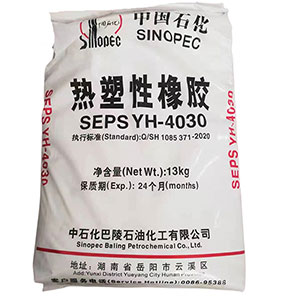SEBS(Styrene Ethylene Butylene Styrene)
PROPERTIES AND APPLICATIONS
Styrene-ethylene-butylene-styrene, also known as SEBS, is an important thermoplastic elastomer (TPE) which
behaves like rubber without undergoing vulcanization.SEBS is strong and flexible, has excellent heat and UV
resistance and is easy to process. It is produced by partial and selective hydrogenating of
styrene-butadiene-styrene copolymer (SBS) which improves the thermal stability, weathering and oil resistance,
and makes SEBS steam sterilisable.However, hydrogenation also reduces the mechanical performance and increases
the cost of the polymer.
SEBS elastomers are often blended with other polymers to enhance their performance. They are used as impact
modifiers for engineering thermoplastics and as flexibilizers / tougheners for clear polypropylene (PP).Often
oil and fillers are added to lower cost and / or to further modify the properties. Important applications
include hot-melt pressure sensitive adhesives, toy products, shoe soles, and TPE-modified bitumen products for
road paving and roofing applications.
Styrenics, or styrenic block copolymers are the most widely used of all TPE's. They combine well with other
materials as well as fillers and modifiers. SEBS (styrene-ethylene/butylene-styrene) is characterized by hard
and soft domains within individual polymer strands. The end-blocks are crystalline styrene while the mid-blocs
are soft ethylene-butylene blocks. At higher temperatures these materials soften and become fluid. When cooled,
the strands join at the styrene end-blocks forming a physical cross-link and providing a rubber like elasticity.
Clarity and FDA approval make SEBS an excellent option for high-end applictions.
Adhesives And Sealants And Coatings
SEBS can improve performance in pressure-sensitive and other adhesive applications. Some of the more common
applications include a variety of tapes, labels, plasters, construction adhesives, medical dressings, sealants,
coatings and road marking paints.
Compounds
SEBS can be compounded to produce materials which improve the grip, feel, appearance and convenience of various
applications. Sports and leisure, toys, hygiene, packaging, automotive, and molded and extruded technical goods
are some common examples.
SEBS can be used in combination with various fillers. Compounders will add these fillers if enhanced oil
absorption, cost reduction, improved surface feel, or additional stabilization is required over pure SEBS.
Probably the most common filler for SEBS is oil. These oils will be chosen depending on specific application
requirements. Adding aromatic oil softens the PS blocks by plasticizing which decreases hardness and physical
properties. Oils make the products softer and also act as processing aids. Paraffinic oils are preferred because
they are more compatible with the EB center block. Aromatic oils are generally avoided because they intrude into
and plasticize the polystyrene domains.
Packaging And Polymer Modification
SEBS can enhance high styrene applications, films, bags, stretch film and disposable packaging. They can improve
the performance of polyolefins for use in extreme temperatures, improve clarity and scratch resistance, and
enhance elasticity.
Main Properties of Each Grade of SEBS Series Products (Typical Value)
| Grade |
Structure |
Block Ratio |
300% Stretching Strength MPa |
Ensile Strength MPa |
Elonga tion % |
Permanent Set % |
Hardness Shore A |
Toluene Solution
Viscosity at 25℃ and
25%, mpa.s |
| YH-501/501T |
Linear |
30/70 |
5 |
20.0 |
490 |
24 |
76 |
600 |
| YH-502/502T |
Linear |
30/70 |
4 |
27.0 |
540 |
16 |
73 |
180 |
| YH-503/503T |
Linear |
33/67 |
6 |
25.0 |
480 |
16 |
74 |
2,300 |
| YH-504/504T |
Linear |
31/69 |
5 |
26.0 |
480 |
12 |
74 |
|
| YH-561/561T |
Mixed |
33/67 |
6.5 |
26.5 |
490 |
20 |
80 |
1,200 |
| YH-602/602T |
Star-shaped |
35/65 |
6.5 |
27.0 |
500 |
36 |
81 |
250 |
| YH-688 |
Star-shaped |
13/87 |
1.4 |
10.0 |
800 |
4 |
45 |
|
| YH-604/604T |
Star-shaped |
33/67 |
5.8 |
30.0 |
530 |
20 |
78 |
2,200 |



